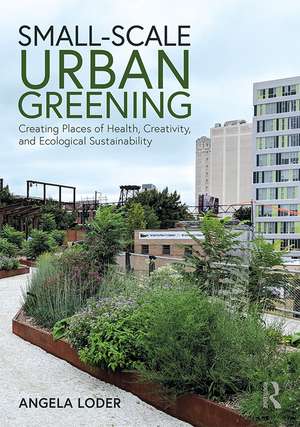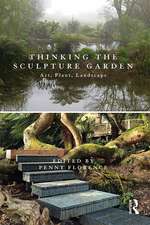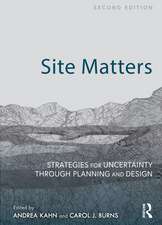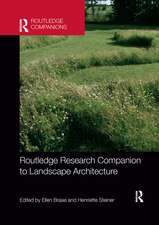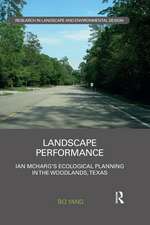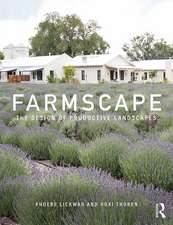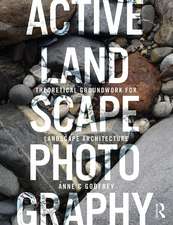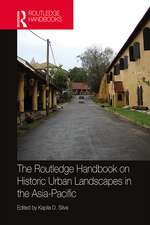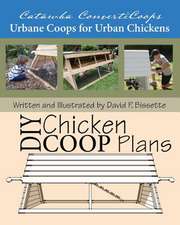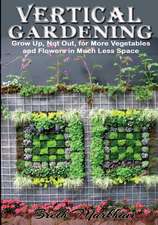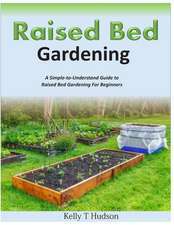Small-Scale Urban Greening: Creating Places of Health, Creativity, and Ecological Sustainability
Autor Angela Loderen Limba Engleză Paperback – 12 mar 2020
| Toate formatele și edițiile | Preț | Express |
|---|---|---|
| Paperback (1) | 248.79 lei 6-8 săpt. | |
| Taylor & Francis – 12 mar 2020 | 248.79 lei 6-8 săpt. | |
| Hardback (1) | 769.92 lei 6-8 săpt. | |
| Taylor & Francis – 17 mar 2020 | 769.92 lei 6-8 săpt. |
Preț: 248.79 lei
Preț vechi: 297.06 lei
-16% Nou
Puncte Express: 373
Preț estimativ în valută:
47.61€ • 49.42$ • 39.70£
47.61€ • 49.42$ • 39.70£
Carte tipărită la comandă
Livrare economică 22 martie-05 aprilie
Preluare comenzi: 021 569.72.76
Specificații
ISBN-13: 9781138187870
ISBN-10: 1138187879
Pagini: 262
Ilustrații: 7 Tables, black and white; 4 Line drawings, black and white; 8 Halftones, color; 12 Halftones, black and white; 8 Illustrations, color; 16 Illustrations, black and white
Dimensiuni: 174 x 246 x 15 mm
Greutate: 0.52 kg
Ediția:1
Editura: Taylor & Francis
Colecția Routledge
Locul publicării:Oxford, United Kingdom
ISBN-10: 1138187879
Pagini: 262
Ilustrații: 7 Tables, black and white; 4 Line drawings, black and white; 8 Halftones, color; 12 Halftones, black and white; 8 Illustrations, color; 16 Illustrations, black and white
Dimensiuni: 174 x 246 x 15 mm
Greutate: 0.52 kg
Ediția:1
Editura: Taylor & Francis
Colecția Routledge
Locul publicării:Oxford, United Kingdom
Public țintă
Postgraduate, Professional, and Professional Practice & DevelopmentCuprins
Introduction: Re-imagining the city: urban greening as creative solution to social and ecological challenges
Chapter 1: Nature, Health, Well-being and Sense of Place: what do we know? What don’t we agree on?
Biological paradigm: adaptive and utility
The Social Construction Paradigm: constructed, political, and relational
New directions in nature, health, and well-being research
Moving forward: research, policy, and practice on nature and health in cities
Chapter 2: Ecology in the margins: Green Infrastructure and stormwater management
Introduction
Ecosystem services, green infrastructure, and stormwater: a short history of re-thinking water in cities
City-wide approaches to urban greening and stormwater: the case of Philadelphia
Piece-by-piece layering and conversion: urban greening and stormwater in Toronto
Small-scale urban greening and green infrastructure: reflections
Links to research and moving forward
Chapter 3: Meadows in the sky: a green roof case study
Introduction
What do we know about green roofs, health, and well-being?
Methods
Results: what did they think and feel about green roofs?
Implications for policy, research, and the human relationship to nature
Asking the same questions in a different way: a survey
Lessons learned from quantitative versus qualitative methods
Conclusion
Chapter 4: Reclaiming the city: vacant lots and post-industrial corridors
Introduction
Marginal spaces: regreening neglected areas
Case studies: Chicago and Philadelphia
Chicago and vacant lots
Vacant lots: Philadelphia
Post-industrial urban greening: elevated parks
Case study: Philadelphia’s Rail Park
Case study: Chicago’s The 606
Small-scale urban greening, interstitial, and post-industrial space: reflections and moving forward
Research and the real-world: opportunities for collaboration and change
Conclusion: Policy lessons and Research Implications: Connecting urbanites to nature and re-thinking urban greenspace
Introduction
Policy
Review of case study conclusions
Lessons learned, looking ahead
Frame the issue
Governance, funding, and legislation
Tactical urbanism, community outreach, and research
A way forward: learning by doing, adaptive planning
Research context
How do we value urban nature as experienced with SSUG projects?
How we experience SSUG: implications for research
Education and design implications for health, well-being, and ecological sustainability
Looking ahead
Chapter 1: Nature, Health, Well-being and Sense of Place: what do we know? What don’t we agree on?
Biological paradigm: adaptive and utility
The Social Construction Paradigm: constructed, political, and relational
New directions in nature, health, and well-being research
Moving forward: research, policy, and practice on nature and health in cities
Chapter 2: Ecology in the margins: Green Infrastructure and stormwater management
Introduction
Ecosystem services, green infrastructure, and stormwater: a short history of re-thinking water in cities
City-wide approaches to urban greening and stormwater: the case of Philadelphia
Piece-by-piece layering and conversion: urban greening and stormwater in Toronto
Small-scale urban greening and green infrastructure: reflections
Links to research and moving forward
Chapter 3: Meadows in the sky: a green roof case study
Introduction
What do we know about green roofs, health, and well-being?
Methods
Results: what did they think and feel about green roofs?
Implications for policy, research, and the human relationship to nature
Asking the same questions in a different way: a survey
Lessons learned from quantitative versus qualitative methods
Conclusion
Chapter 4: Reclaiming the city: vacant lots and post-industrial corridors
Introduction
Marginal spaces: regreening neglected areas
Case studies: Chicago and Philadelphia
Chicago and vacant lots
Vacant lots: Philadelphia
Post-industrial urban greening: elevated parks
Case study: Philadelphia’s Rail Park
Case study: Chicago’s The 606
Small-scale urban greening, interstitial, and post-industrial space: reflections and moving forward
Research and the real-world: opportunities for collaboration and change
Conclusion: Policy lessons and Research Implications: Connecting urbanites to nature and re-thinking urban greenspace
Introduction
Policy
Review of case study conclusions
Lessons learned, looking ahead
Frame the issue
Governance, funding, and legislation
Tactical urbanism, community outreach, and research
A way forward: learning by doing, adaptive planning
Research context
How do we value urban nature as experienced with SSUG projects?
How we experience SSUG: implications for research
Education and design implications for health, well-being, and ecological sustainability
Looking ahead
Notă biografică
Angela Loder is Vice President, Research, for the International WELL Building Institute. In this role she is responsible for identifying, directing, and managing evidenced-based research that supports the WELL Building Standard. She has been a core member of the Health in Buildings Roundtable (HiBR) with the National Institutes of Health since 2009. She is a Canada-U.S. Fulbright Scholar, a board member of the Institute for the Built Environment at Colorado State University, Adjunct Faculty at the University of Denver, and part of the first cohort of WELL Faculty and a WELL AP. She holds a collaborative PhD in Health and Urban Geography and Environmental Studies from the University of Toronto.
Recenzii
"Small-Scale Urban Greening provides an excellent summary of the literature regarding human interaction with nature, ranging from a thorough explication of research to a detailed discussion of public policy. The examples involving green infrastructure, roofs, vacant lots and industrial corridors enhance our understanding of the impact of urban nature interventions."
Mardelle McCuskey Shepley, D.Arch., FAIA, Chair and Janet and Gordon Lankton Professor Design + Environmental Analysis, CORNELL UNIVERSITY
"Angela Loder masterfully shines a light on the opportunity for the leftover, marginal and abandoned spaces in our urban environments to become green spaces that connect us to nature. Small-Scale Urban Greening is a comprehensive review of the research, case studies, and policy that can make these opportunities come to life and provide the critical links between health, equity and community that are so badly needed in our cities."
Amanda Sturgeon, FAIA, Head if Regenerative Design, Mott MacDonald
Mardelle McCuskey Shepley, D.Arch., FAIA, Chair and Janet and Gordon Lankton Professor Design + Environmental Analysis, CORNELL UNIVERSITY
"Angela Loder masterfully shines a light on the opportunity for the leftover, marginal and abandoned spaces in our urban environments to become green spaces that connect us to nature. Small-Scale Urban Greening is a comprehensive review of the research, case studies, and policy that can make these opportunities come to life and provide the critical links between health, equity and community that are so badly needed in our cities."
Amanda Sturgeon, FAIA, Head if Regenerative Design, Mott MacDonald
Descriere
This book argues that including power dynamics, symbolism, and aesthetics in our understanding of the human relationship to urban nature can help us create places that nurture ecological and human health and promote successful and equitable urban communities.
